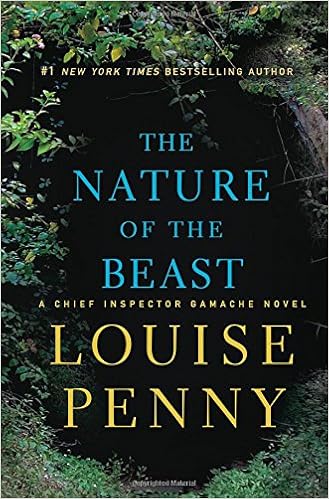
The Nature of the Beast feels like a return to form for Louise Penny. It's not that the last book was bad - it was still pretty good. I'm just so used to superlatively good that merely good is a bit of a letdown. Last year was the first year in a while that one of her books hasn't made my year-end Top Ten. We'll see how next year shakes out, but this has all of the things I love about Penny's mystery series.
Gamache and his wife are still in Three Pines, although the job offers for Gamache have been pouring in, and it seems likely he'll be back in some kind of active service in the next book or so. (I've seen pictures of the cover of the ARC on Twitter a couple of times this last week, so I know it's coming on schedule.) A young boy who always tells tall tales comes running into Olivier and Gabri's bistro, talking about a gun as big as a house.
The next day, he's found thrown from his bike, dead in a ditch. It's written off as an accident, but Gamache realizes that some things don't add up. His old team shows up, LaCoste and Beauvoir, to investigate, and they find that the gun as big as a house is far from a story - it's hidden out in the woods, a weapon of legend. A missile launcher without electronics, made by a weapons designer who was murdered in Brussels decades previously.
Two CSIS agents show up, file clerks who know about the designer, as a does a university professor. Unsettlingly, the case seems to bring up casual references to the worst serial killer in Quebec history, at whose trial Gamache found out more about depravity than anyone would ever want to.
It's a race to find the boy's killer before the news of the giant gun gets out, and to negotiate a murder investigation against CSIS agents who think their investigation is more important.
So why do I say that it's a return to form? It's tighter, I think, than the last book. Gamache is mostly recuperated and almost back in action, although careful not to undermine Isabelle in her new role. The mystery is compelling. We also get some new insight into Ruth Zardo and her history, and as Ruth is one of my favourite characters, that's very welcome.
There's an undercurrent here, about art, and intention, and of the ways that art can be an expiation, or, more unsettling, a way to avoid dealing with the past while thinking that you are. Getting stuck on what you think you should be doing instead of moving forward to find the next moment in your life. It's very much a side story centered around Clara, but those last moments were very powerful.
The thread about the gun and the threat it poses to the world is also strong. While they're trying to find the murderer of a child, others are trying to get control of the gun, or find its plans or missing firing mechanism. There are those in the world who would be more than glad to get their hands on it, and that has to be a consideration. But smaller stories must not get lost just because there are big ones, and Penny does a good job of juggling both.
I don't know what else to say. It was a thoroughly satisfying mystery, with an ending I didn't see coming, but which made a macabre sort of sense. There's also some set up for, I presume, later books, with the serial killer. I'm not fond of fiction with serial killers, as a rule, but I'd made an exception for Penny, because I believe she'd have a reason for it.
Is the missile designer's name by chance Gerald Bull? https://en.wikipedia.org/wiki/Gerald_Bull
ReplyDeleteIt is! And she uses his real name and what's known about him.
DeleteI always geek out a bit when I come across him - I heard his story when I was a wee co-op working for DND from someone who, I think, had met the guy.
DeleteThen I would recommend this book! Although it is the rare mystery series that it is hard to pick up mid-way through.
Delete